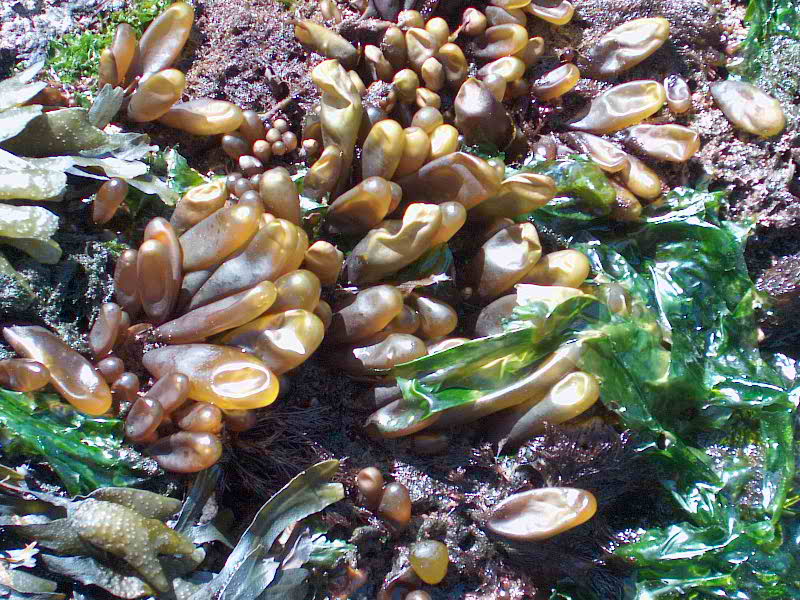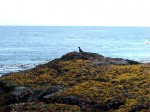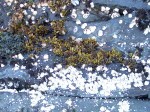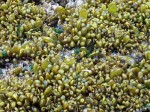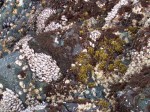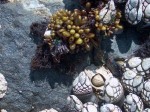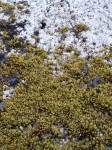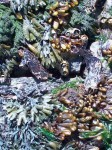Distinguishing Characteristics :
Typical descriptions of Halosaccion glandiforme depict the plant as a thin-walled elongated sausage-shaped sac found in the mid-intertidal region of rock dominated shores. The plant is identifiable by its rounded head and short stipe anchored by a small circular holdfast. It ranges in colour from yellow/brown to red/purple. Also, because of the water it contains, applying pressure to the plant produces fine sprays of water emitted from the pores. In Common Seaweeds of the Pacific Coast (by J. Robert Waaland) it is stated that “Halosaccion glandiforme may reach lengths up to 25 cm and 3 to 4 cm in diameter; typical sizes are about 15 cm long by 2 to 3 cm in diameter.”
The following pictures were taken by Ryan Murphy, 2005
- Another dense field of H. glandiforme
- Pigeon Guillemont on field of H. glandiforme
- H. glandiforme showing banding growth patterns
- A dense H. glandiforme field
- H. glandiforme with E. muricata and barnacles
- H. glandiforme growing on gooseneck barnacles
- H. glandiforme’s range overlapping with barnacles
- H. glandiforme shown with Ulva lactuosa
Domain: Eukarya
Kingdom: Protoctista
Division: Rhodophyta
Class: Rhodophyceae
Subclass: Florideophycidae
Order: Palmriales
Family: Palmariaceae
Genus: Halosaccion
Species: glandiforme (Gmelin) Ruprecht 1851
Common Name: sea sac
Biotic Associations:
Being an intertidal species Halosaccion glandiforme shares its ecological niche with several other intertidal dwelling species. Acrochaetium vagum, a different red algae, is an epiphyte to Halosaccion. Also such species as mussels, barnacles, and species from other algal divisions including Poryphera lancelota, and Fucus gardneri grow in the same vacinity of the intertidal zone as Halosaccion. Predation on the Halosaccion is limited, the most common source of predation is from molluscan grazers like the sea snail Tegula funebralis.
In a study done on Halosaccion at Bamfield Marine Station in 1983, Garry Fletcher found an association of microscopic nematodes dwelling inside the sac of intact Halosaccion. Also noted were the special aggregation of cells that formed the “holes” on the walls of the algae.These are not random pin holes but very specialized regions of the matrix of the water reservoir wall.
References and Sources of More Information:
Fletcher, Alex, INTERTIDAL ZONATION OF HALOSACCION GLANDIFORME: A FOCUS ON HEIGHT AND SLOPE AS FACTORS OF ZONATION, extended essay in Biology, 2002
Johnson, L.E. 1992. Potential and peril of field experimentation: the use
of copper to manipulate molluscan herbivores. Journal of Experimental Marine
Biology & Ecology, v160 n2, pp251-262.
 The Race Rocks taxonomy is a collaborative venture originally started with the Biology and Environmental Systems students of Lester Pearson College UWC. It now also has contributions added by Faculty, Staff, Volunteers and Observers on the remote control webcams. Dec 2001–Alex Fletcher PC. The Race Rocks taxonomy is a collaborative venture originally started with the Biology and Environmental Systems students of Lester Pearson College UWC. It now also has contributions added by Faculty, Staff, Volunteers and Observers on the remote control webcams. Dec 2001–Alex Fletcher PC. |

